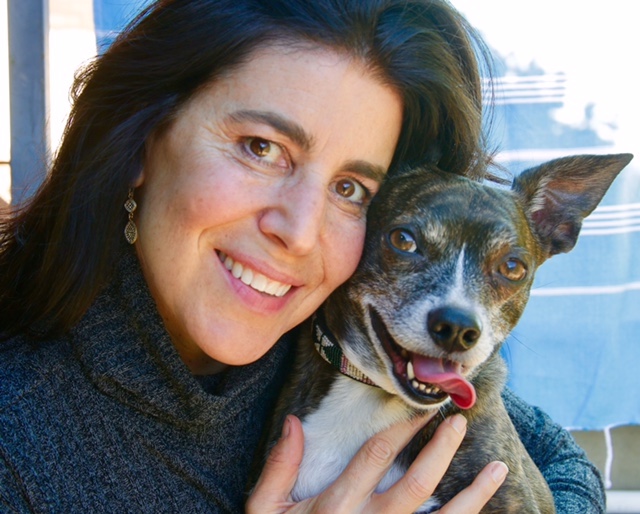
KAREN ROSEN

Karen Rosen is the program director/co-founder of the K9 Youth Alliance. Koa is a dog.DDD: Tell us what K9 Youth Alliance does?
KR: K9 Youth Alliance connects teens from vulnerable circumstances and underserved environments with dogs living in a shelter. We provide a program that lasts thirty hours: three weeks, two hours a day, five days a week. For the first hour of each session we teach the kids how to work with the dogs and develop skills that will make it more likely that the dog will be adopted.
In the second hour we do life skills activities that are connected to what they’re learning with their dog – so it’s how to communicate, trusting relationships, developing empathy, setting goals, what to do when change happens. Because a lot of times the dogs get adopted mid-program so we’re able to support the kids’ feelings.
So the kids don’t take the dog home?
No. At the end of the three weeks the kids take the dogs through a public graduation ceremony where they can invite friends and family. They take the dogs through a mini-obstacle course and then give a presentation about their experience. It’s always an incredible day because at the beginning of the program all of the kids are saying that they’re not going to do any speeches in front of people, but by the end their confidence has developed so much from having worked with their dogs and they’re so proud about the work that they’ve done, they always want to stand up and give a speech about it.
How do you find the children?
What we do is we go to schools and community organizations and give a short presentation about what the program is and we usually bring a dog. Then the kids fill out an application and then we interview them because we’re also trying to develop their vocational skills. A lot of times this is the first time that they’ve filled out an application, the first time that they’ve had a job interview and we consider it kind of like a job.
The first two programs we held were with kids from Boys and Girls Club. They come from different socio-economic groups but I think 80% of the kids who attend Boys and Girls fall into the free school lunch which means they’re of a lower socio-economic status. So K9 Connection works primarily with kids in continuation schools, which is a different vulnerable population.
There are so many underserved populations, in fact our next partner is going to be Hillsides Education Center, which is a school for kids with special needs. So they are going to be bringing their kids — again, 6 kids – to the shelter. Brian, you should come to our next graduation, February 10th.
Absolutely!
It’s hard to get the full idea unless you’re seeing what happens.
How do you decide which dogs are going to be in the program?
We work very closely with the Pasadena Humane Society — or whoever the partner shelter or rescue is — to pick dogs that are going to have some success in the program. So they obviously can’t be aggressive towards kids, they can’t have food guarding issues. We work with the Pasadena Humane Society to assess the dogs to make sure that we’re taking into account safety first.
We also try to choose a variety of dogs. We want to have bigger dogs, smaller dogs, fluffy dogs — so that the kids have a choice. And we also want to get dogs with various energy levels, so that the kids can learn and connect with their energy being similar or dissimilar to a dog. I remember at K9 Connection we once had this guy who was gigantic — probably 300 pounds and in tenth grade — and he wanted a big dog. And usually we try to give the kids what they request but it didn’t work out in this case so he got this smaller dog that he ended up, by the end of the program, just in love with. And it was a perfect fit for him because he learned something different about himself by working with a smaller dog.
When was the program started?
2016 was our first operating year. We have two partners, the Pasadena Humane Society and the Boys and Girls Club. The Boys and Girls Club brings their kids – 6 kids at a time – to the Pasadena Humane Society, and that’s where we do the training.
What’s the age range of the kids in the program?
It’s 13 and up. We take up to eighteen years old. One of the great things about our program is that it’s a proven one. We’re modeled after K9 Connection, which is in West LA and been around for ten years. We love the program so much that we wanted to develop it in other areas of the city. And now we’re expanding to other shelters and we’re slated to do a program with Los Angeles Animal Services sometime this year.
Didn’t you start out at K9 Connection?
I did. That’s how I got my experience. First I was a volunteer and then I was an alumni advocate and then I was a volunteer coordinator and I also was a resource board member. So I got to see all of the ins and outs of developing a non-profit. Plus, my interest is in program development and volunteer coordination.
Tell me a success story.
One of the tenets of the program is that we keep connected with the kids through activities called check-backs. So we will periodically have everybody meet at the shelter. Hopefully, that keeps the kids connected to what it was that they learned so they’re not only learning in that three-week period, but taking their experience and extending it beyond. One of the projects we’re doing now is public service announcements. We’re working with the kids on a PSA that we’re going to launch on our YouTube Channel called “Teens to the Rescues: Top Ten Reasons to Adopt a Dog from a Shelter.” So that’s one success story that came from a lot of brainstorming with the kids. The other type of success story is that every dog we’ve had in the program – about fifteen dogs – have gotten adopted from the shelter.
But the student who comes to my mind most, when I think of success stories, is Jen. Jen was very under confident, very shy. She said the entire way through that she wasn’t going to give the speech. And we didn’t really know if, when the day came, she’d really be able to stand up in front of people — because she’d never done anything like that before. But with the support of our volunteers and her dog right there – Jen was able to speak about what she discovered about herself through the program. And it was an incredible experience because she had really come so far.
Are there any speeches available?
There are.
My computer just pinged. It must be the speeches that you just sent!
Melinda and Honey Badger
Hey, my name is Melinda and this is my amazing dog Honey Badger. I wanted to be a part of the K9 Youth Alliance program so I can teach the dogs at SC Cat Adoption Tails some tricks. My closest dog at that program was Cappuccino. He was so amazing! Honey Badger is 5 years old. She is fun, and cute. She is fast if you motivate her. She knows sit and spin. She loves attention from everyone. She’ll come up to me and sense if I am having a good day or bad day and still come to say hi. In this program I worked with 4 dogs. 3 got adopted. One of the dogs I worked with was Jango Jango was so amazing! One of the tricks I taught him were “Manos Aribas”. He was very sweet, loving, fun and cool. From Jango I learned that he was nervous, but the thing is I felt nervous on the first day. Setting goals was amazing. I LOVE DOGS SO MUCH!
***
Alonso and Billie
Hi! My name is Alonso and this is my dog Billie. Billie knows “sit” “down” “come” “stay” “spin” “take a bow” “catch” “find a treat”. She likes to eat chicken, cheese, and Zukes. She loves chew sticks. Billie is shy and her favorite place to be pet is under her chin. Billie is fast, doesn’t miss a meal, is fun and always happy. Billie is about 2 years old. She is a bit shy toward big dogs. I think you should adopt Billie because she is very sweet, big and lovable. Billie has taught me to be more animated and excited to work with and love animals. Also I felt more confident while training Billie and to take baby steps if she doesn’t get it the first time, and how to set goals.
I very much recommend this program to others.
***
Elia and Toby
Hi my name is Elia and my dogs name is Toby.
Toby is 10 months old and loves toys.
He is outstanding.
He is a boy.
He has youthful energy.
He knows sit, down, his butt down and roll over.
I think you should adopt him because he is lovable, and he has a lot of energy.
Also he learns quickly.
I like working with Toby because he is lovable and he is fun to work with.
My favorite part of classroom activities was getting Toby to focus and not to bark in class.
I watched Toby to learn how to be patient.
For me it reminded me to be patient in life.
Thank you, Karen. And if anybody out there is interested in getting involved in the program click on this link!





